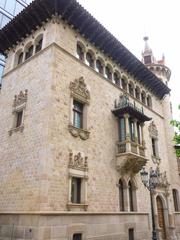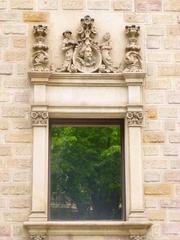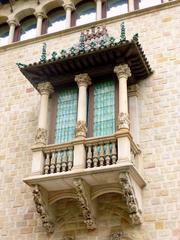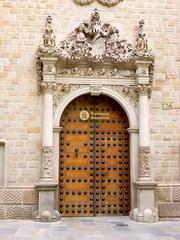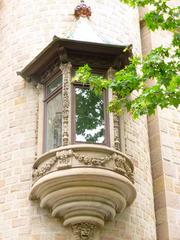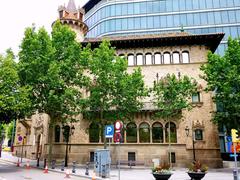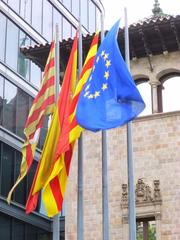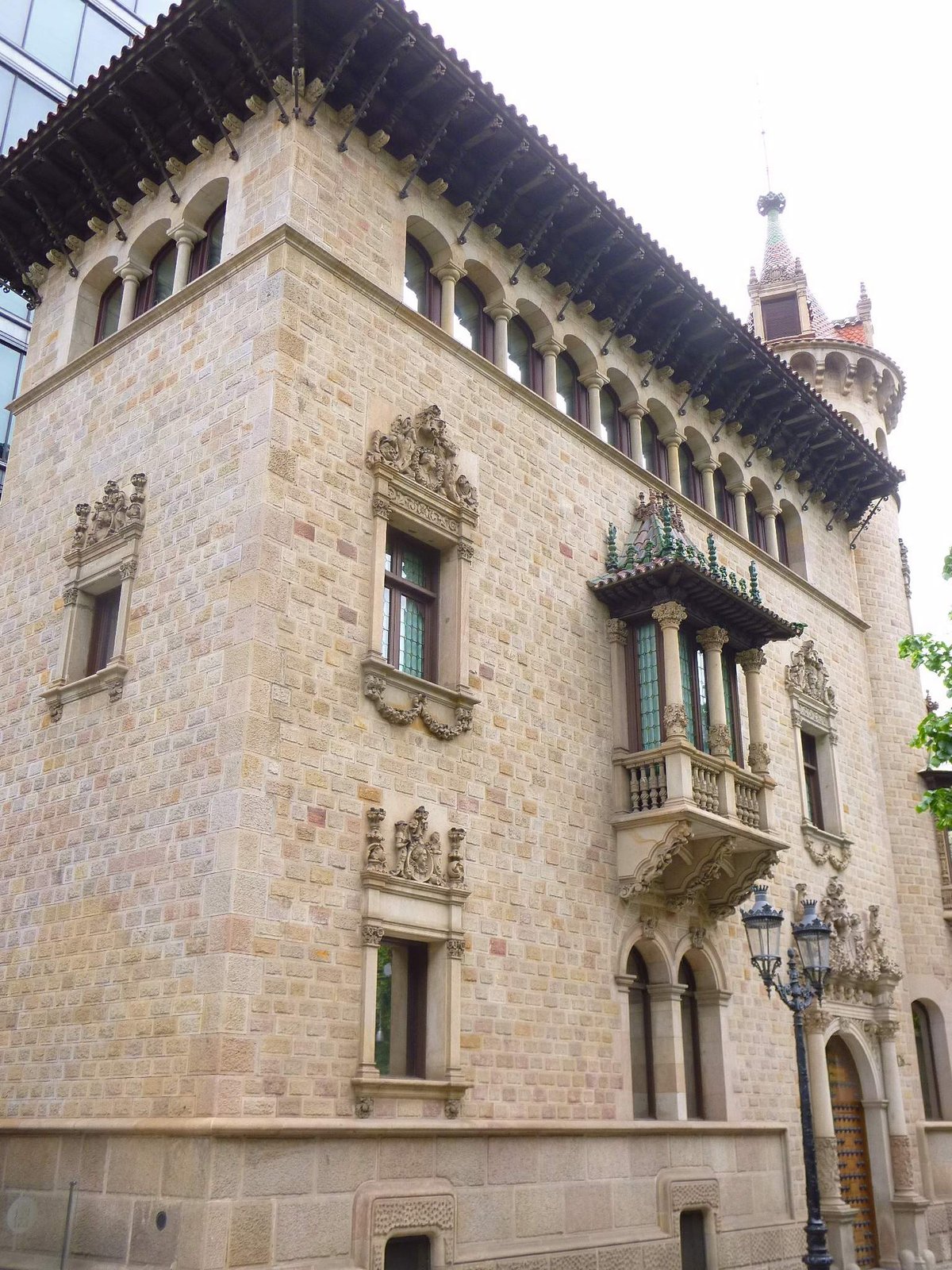
Casa Serra Barcelona Visiting Hours, Tickets, and Visitor Guide
Date: 15/06/2025
Introduction to Casa Serra Barcelona: History & Cultural Significance
Casa Serra is one of Barcelona’s most compelling examples of Catalan Modernisme and a reflection of the city’s architectural ingenuity in the early 20th century. Situated at Rambla de Catalunya 126, at the junction with Avinguda Diagonal, this historic building is a striking urban landmark in the Eixample district. Casa Serra was designed by Josep Puig i Cadafalch, a leading figure in the Modernisme movement and a contemporary of Antoni Gaudí. The building’s neo-Gothic flourishes, intricate stonework, sculptural busts, and its conical tower have made it a magnet for architecture enthusiasts and admirers of Barcelona’s cultural evolution (Lonely Planet; Wikipedia - Casa Serra; city.cat).
Commissioned by merchant Pere Serra i Pons in the early 1900s, the building’s initial role as a grand family residence was never fully realized due to financial and health setbacks. Over the years, Casa Serra has adapted to various purposes, including serving as a religious school and, today, as the seat of the Diputació de Barcelona. This transformation highlights both the layered history of the building and Barcelona’s commitment to heritage preservation (Arquitectura Catalana; Agenda21Culture).
Though Casa Serra is not generally open to the public for interior visits, its façade and urban presence remain accessible, making it a rewarding destination for those interested in Modernisme. This guide offers a comprehensive look at Casa Serra’s historical context, architectural highlights, practical visitor information, accessibility, and tips for making the most of your visit. For those exploring Barcelona’s architectural treasures, nearby icons like Casa Batlló and Casa Amatller offer further insight into the city’s modernist landscape (Barcelona Tourist Guide; fullsuitcase.com).
Table of Contents
- Introduction
- Historical Context
- Architectural Highlights
- Visiting Casa Serra: Practical Information
- Frequently Asked Questions (FAQs)
- Conclusion & Planning Resources
Historical Context
Origins and Early Development
Casa Serra, also known as Can Serra, occupies a prominent corner at Rambla de Catalunya and Carrer de Còrsega. Its history begins with Pere Serra i Pons (1846–1919), a merchant from Manresa who, after moving to Barcelona in 1874, acquired several plots in the Eixample district to build a prestigious family home (Wikipedia - Casa Serra). After initial renovations by Domènec Boada, Serra commissioned Josep Puig i Cadafalch in 1901 to design an ambitious new residence. Construction began in 1902, with expansions added in 1903, including a carriage entrance on Diagonal (Arquitectura Catalana).
Architectural Vision and Evolution
Puig i Cadafalch’s design united two façades with a signature corner tower, planned a rooftop garden-pergola, and cleverly exploited the site’s slope with a semi-basement—all reflecting the inventive spirit of Modernisme (Wikipedia - Casa Serra). Financial and health issues halted construction in 1905, and the Serra family never moved in.
Institutional Transformation
In 1908, the Companyia de Santa Teresa de Jesús acquired the unfinished property. Architect Gabriel Borrell i Cardona adapted the building into a school and residence for nuns, offering kindergarten, secondary schooling, and teacher training (Wikipedia - Casa Serra).
Heritage Recognition and Restoration
Heritage status was granted in 1961, but Casa Serra faced demolition threats in the late 1960s. Persistent advocacy led to its declaration as a historic-artistic monument in 1971, and it was restored and repurposed as the Diputació de Barcelona’s headquarters in 1987 (Arquitectura Catalana).
Symbolism and Artistic Elements
The entrance displays a unique coat of arms reflecting the Serra family’s aspirations. Sculptural busts of Pere Serra and his wife add a personal touch to the façade (Wikipedia - Casa Serra). Despite later modifications, the building’s modernist spirit is unmistakable.
Casa Serra in the Modernisme Movement
Casa Serra stands alongside Casa Amatller and Casa Batlló as a crucial work of Catalan Modernisme, embodying the creativity and urban optimism that shaped Barcelona in the early 1900s (Lugaris - 12 Famous Historic Buildings in Barcelona).
Architectural Highlights
Facade and Decorative Features
Casa Serra’s façade is a showcase of neo-Gothic and modernista artistry, constructed from Montjuïc stone and adorned with intricate tracery, stone mullions, and a dramatic conical central tower. The exterior is highlighted by sculptural busts created by Eusebi Arnau and Alfons Juyol, depicting cultural icons like Miguel de Cervantes and Marià Fortuny (Lonely Planet; Pobles de Catalunya). The blend of pointed arches and elaborate stonework echoes both medieval and modernist influences.
Interior Artistry
Although adapted for government use, elements of the original interior survive, including decorative ceilings, stained glass, and wrought ironwork. Notable features include reliefs such as the Saint George wax relief by Apel·les Fenosa, reinforcing the building’s Catalan narrative (Pobles de Catalunya).
Urban Presence
Casa Serra’s strategic position on bustling Rambla de Catalunya ensures its integration into the city’s social and architectural life. The building maintains harmony with neighboring structures through the use of traditional Catalan materials and forms, while its ornate detail sets it apart (Barcelona Tourist Guide).
Visiting Casa Serra: Practical Information
Location and Access
Casa Serra is located at Rambla de Catalunya 126, Eixample, Barcelona (city.cat). The nearest metro stations are Diagonal (L3, L5) and Passeig de Gràcia (L2, L3, L4), just a short walk away. Multiple city buses also serve the area, and the surrounding streets are pedestrian-friendly.
Visiting Hours and Tickets
Casa Serra is primarily a government building and not open to the public for regular interior tours. The exterior can be viewed from the street at any time. Occasionally, special events or cultural festivals—such as European Heritage Days—offer guided tours or exhibitions inside. These typically require advance booking and may have a modest fee (city.cat; Diputació de Barcelona).
Accessibility
The area surrounding Casa Serra is wheelchair accessible, though interior access depends on event-specific arrangements. For details about accessibility during special events, consult the official Diputació de Barcelona website.
Guided Tours and Special Events
Guided tours are rare but are sometimes organized during architecture festivals or heritage days. For announcements, refer to the Diputació de Barcelona website or local tourism offices.
Nearby Attractions & Visitor Tips
Combine your visit to Casa Serra with nearby modernist marvels such as Casa Batlló, Casa Amatller, and Casa de les Punxes (fullsuitcase.com). Rambla de Catalunya is a lively avenue with cafés, shops, and a vibrant atmosphere—ideal for exploring on foot.
Practical Tips
- Photograph the façade in early morning or late afternoon light for the best results.
- Plan ahead for special events or tours by checking official websites.
- Use public transit to avoid parking hassles.
- Dress smart-casual and keep valuables secure (theinvisibletourist.com).
- Support local businesses for a more authentic experience.
Frequently Asked Questions (FAQs)
Q: What are Casa Serra’s visiting hours?
A: Casa Serra is not open for regular public visits; its exterior can be viewed any time. Interior access is possible only during special events.
Q: Do I need a ticket to visit Casa Serra?
A: No ticket is needed to view the exterior. Tickets may be required for guided tours or special exhibitions.
Q: Is Casa Serra accessible?
A: The exterior area is accessible. Interior access during events should be verified in advance.
Q: Are guided tours available?
A: Occasionally, during special cultural events. Check official sources for updates.
Q: Can I take photographs?
A: Yes, photography of the exterior is permitted.
Q: What’s the best way to reach Casa Serra?
A: By metro (Diagonal or Passeig de Gràcia stations) or by public bus; the area is pedestrian-friendly.
Conclusion
Casa Serra stands as a testament to the inventive spirit of Catalan Modernisme and the adaptive resilience of Barcelona’s urban fabric. While its interiors are typically off-limits, the building’s richly detailed façade and historic significance make it a must-see for visitors interested in architecture and cultural history. Its location in the heart of Eixample, surrounded by other Modernista landmarks, makes Casa Serra an ideal starting point for exploring Barcelona’s architectural heritage. To enrich your experience, plan ahead for potential guided tours or cultural events, and consider combining your visit with a walking tour of nearby modernist buildings.
Call to Action
For the latest updates on Casa Serra visiting hours, special events, and guided tour opportunities, download the Audiala app and follow us on social media. Stay informed about Barcelona’s architectural gems and access exclusive travel tips and resources to make your visit unforgettable.
Essential Information at a Glance
- Address: Rambla de Catalunya 126, Eixample, Barcelona (city.cat)
- Nearest Metro: Diagonal (L3, L5), Passeig de Gràcia (L2, L3, L4)
- Public Access: Exterior viewing only; interior tours during special events
- Best For: Architecture and history enthusiasts, cultural travelers
- Nearby Attractions: Casa Batlló, Casa Milà, Casa Amatller, Passeig de Gràcia
Useful References and Official Resources
- Casa Serra (Barcelona): Visiting Hours, Tickets, and History of this Modernist Gem, 2025, Arquitectura Catalana
- Casa Serra Barcelona: Visiting Hours, Tickets, and Architectural Highlights, 2025, Lonely Planet
- Casa Serra Visiting Hours, Tickets, and Cultural Significance in Barcelona, 2025, Agenda21Culture
- Casa Serra Visiting Hours, Tickets, and Guide to Barcelona’s Historic Landmark, 2025, city.cat
- Casa Serra Wikipedia, 2025
- Barcelona Tourist Guide: Modernisme Landmarks, 2025
- FullSuitcase Barcelona Travel Tips, 2025
- Diputació de Barcelona Official Website, 2025
- Audiala App for Barcelona Tourist Information, 2025
